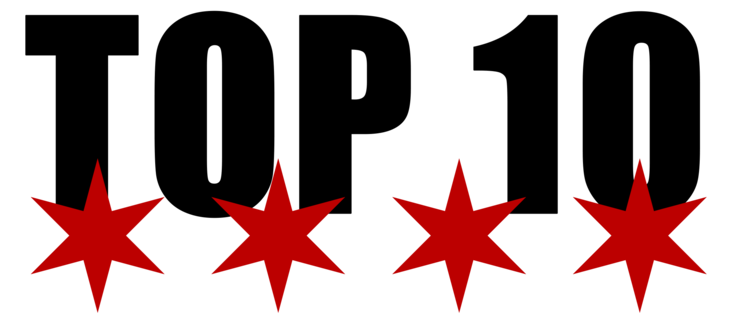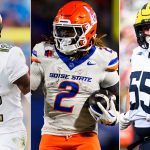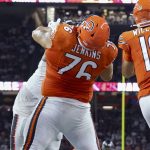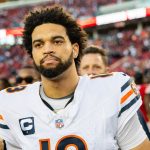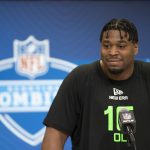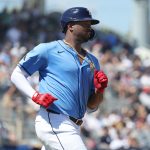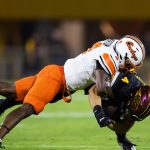The Chicago Bears 2005 draft is indelibly marked on the minds of many fans to this day. No one can say it was a complete failure. Not to the extent of other classes before or since. However, it’s substantial disappointment had an effect far-reaching more than most would’ve thought. Not only to the immediate hopes of the franchise, but also their windows of opportunity down the road.
The process was run by a veteran front office at that point. One that had been together for almost four years. Confidence was high. They’d proven themselves capable of finding and securing top quality talent in the past. Chances were there for them to score big again with a top 5 choice in the 1st round and a full complement of seven picks in total.
This is the story of a three-day span 14 years ago that caused irreparable damage to a roster-building process that would see the Bears reach their first Super Bowl in over two decades. Reach it, but ultimately prevent it from claiming their second Lombardi Trophy. All because of a deeply flawed scouting process and unwillingness to stay open-minded.
Chicago Bears 2005 draft could’ve been the turkey
Avid bowlers will know the term “turkey.” It represents what happens when somebody rolls three-consecutive strikes. Going into 2005, the Bears had already engineered two of them. After a decent first year in 2002, new GM Jerry Angelo scored big with his next two. In ’03 he produced the biggest sequence of his career in an NFL front office.
Subscribe to the BFR Youtube channel and ride shotgun with Dave and Ficky as they break down Bears football like nobody else.
During the 2nd and 3rd round he secured cornerback Charles Tillman and linebacker Lance Briggs. Two players who would become stars on the Bears defense for the next decade. They were joined by Todd Johnson, Justin Gage, Ian Scott, and Bobby Wade. All of whom became capable reserves and special teamers.
The next year, Angelo’s hot hand continue. He grabbed Oklahoma defensive tackle Tommie Harris with the 14th overall pick. A future three-time Pro Bowler. Vertical threat wide receiver Bernard Berrian arrived in the 3rd and eventual Pro Bowl cornerback Nathan Vasher came in the 4th. Just like that, the Bears had added four Pro Bowl players in the space of a calendar year.
It was plain to those close to the team that they were building something special. Brian Urlacher and Olin Kreutz were already in place. One more good April in 2005 might just put them over the top.
A loaded class
The 2005 draft class can be looked back on today has one of the more loaded in recent memory. To offer an idea of how stacked it was? Of the first 15 picks in that class, 11 of them eventually made it to the Pro Bowl. Three players from that year are locks for the Hall of Fame and two of them are still playing. It was a deep, athletic, and diverse group.
Chicago had every reason to feel confident about their chances. Having gone 5-11 the previous season, they held the 4th overall pick in the draft. This presented a huge opportunity to add a premier talent to a roster they felt was on the rise. It came down to how things would shape up ahead of them. Odds were high they’d get at least one player they wanted.
Nobody knew at the time that there were serious problems behind the scenes. Ones that would torpedo their chances of executing the draft properly as they had the two previous years. It began with one of the most infamous 1st round picks in team history.
Everything begins with Cedric Benson
Cedric Benson was a college icon out of Texas by the time he arrived at the draft that year. He’d been the first superstar back out of Texas since fellow Longhorn legend Ricky Williams with 5,540 yards and 64 touchdowns. He also caught 69 passes for 621 yards. So he was viewed by many as one of the best offensive players in the entire class.
He looked like a franchise back. Angelo being a GM steeped in an old school background of defense and power running, undoubtedly was taken by him. So much in fact that the Bears reportedly tried hard to get Benson to agree to a contract before they’d even turned in the card to pick him. Benson had serious reservations going to Chicago as he told Jack Silverstein of Windy City Gridiron.
Part of the issue was the Bears already had an established running back in Thomas Jones. One the coaching staff really liked. So when Angelo made the pick, it came as a shock to several people in the locker room. Something that he believes created instant resentment against him.
“He was a fan of Thomas Jones. He was supportive of Thomas Jones. (Pause.) In my personal opinion, as a head coach or a general manager, all these things should have been addressed before I showed up. They should have been addressed with the team. They should have known they were going to pick me and make it known, so that when I came in, everybody wasn’t surprised. It was tough man. It was an uphill climb for me in Chicago.”
Benson didn’t help his own cause either.
The running back continued his tough negotiations over his rookie contract. This led to a holdout that lasted all the way until the end of the preseason. When he finally did arrive, it wasn’t to the warmest reception. Defensive players were already rallied around Jones. Olin Kreutz made matters tougher with his reported sharp criticisms and constant urges to get better.
It was a lot for Benson to handle. Nobody saw problems outside the team. The Bears ran the ball well that year and even better in 2006 during their run to the Super Bowl. Benson averaged 4.1 yards per carry and scored six touchdowns. He added another in the NFC championship against New Orleans. Things were starting to come together.
Then all the goodwill he’d built up fizzled out. On just his second carry of the big game in Miami, he was hit by Indianapolis Colts safety Bob Sanders. Benson fumbled the ball and also suffered an injury that knocked him out of the game. It was considered one of the pivotal moments of the contest. The Bears offense never found their rhythm again after it.
Benson failed to recover from that disaster. The next year, the Bears traded Jones to the Jets and made him the starter. He struggled most of the season before breaking his leg against Denver. That would be the final moment of his career in Chicago. The following offseason he suffered multiple run-ins with police authorities and was eventually cut.
All that was left was for people to ask how it went so wrong.
Jerry Angelo believes problem was narrowing the draft focus
The obvious question is why did the Bears even take him if there was any inkling that Benson didn’t want to be there? Angelo had an explanation for that. One he takes the blame for. In 2005, he felt that the defense was set. Not a surprise with the wealth of talent they’d acquired to that point. Thus the entire focus of that draft was upgrading the offense.
He told Dan Pompei and Bleacher Report that this was one of his most regrettable career mistakes. That decision caused him to do far less work on defensive players in the 2005 class. If he’d not taken that path, he knows for a fact there would’ve been one player who immediately caught his attention and likely became the #4 pick.
“In that draft, we dismissed defensive players, in particular DeMarcus Ware, because we felt we needed to bring some juice to the offense,” former Bears general manager Jerry Angelo said. “We were fixed on that. If we had been more open-minded and stayed true to who we were, we would have taken Ware. He would have had a much greater impact on our team, because we had Thomas Jones at running back.
Ware would have played into the strength of who we were. We should have spent more time looking at him because we would have seen how special he was.”
Ware eventually went to the Dallas Cowboys. He had eight sacks his rookie season and 11.5 in 2006. Imagine if the defense had him, Adewale Ogunleye, Alex Brown, and Mark Anderson as a rotation that year. Things might’ve been a lot different for Peyton Manning in that Super Bowl. Ware eventually retired with 146 career sacks and nine Pro Bowls.
Yet while it’s big of Angelo to admit that mistake, it doesn’t erase the fact that his offensively-focused approach failed anyway.
Fatally-flawed eyes for offense
Up to that point in his career, Angelo was developing a reputation for poor drafting when it came to offensive players. His very first pick was tackle Marc Columbo, who proved to be an injury-prone bust. Quarterback Rex Grossman arrived the next year. He became an erratic starter for the team despite helping them to the Super Bowl in ’06. Berrian stood out as the only decent pick to establish himself from the previous two classes.
It looked like the Benson move was made out of minor desperation. Angelo needed an early round hit on offense to counter his previous misses. Running back was the safest position a GM could draft on that side of the ball and the Texas star was as close to a sure thing as one was likely to find. The problem is those facts didn’t change how flawed his handling of that sequence was.
There is no question that Benson was the only offensive player left on the board who was worth a top 5 pick. Cadillac Williams went one pick later at #5 but he was more of a mystery coming out of Auburn. He’d had two great years before the draft but didn’t have near the credibility Benson did.
Wide receivers Troy Williamson and Mike Williams went at #7 and #10 respectively. Williamson was a speed demon with considerable questions about his hands. Williams excelled at USC but came out after his sophomore season, so he was young and still raw. So this begs the question.
If Angelo wanted to avoid Benson, why didn’t he trade down?
It isn’t like he hadn’t done it before. Two years ago in 2003, he traded out of the #4 pick, securing two 1st rounders at #14 and #22. The answer is simple enough. That trade had pretty much ended in disaster. The 14th pick became defensive end, Michael Haynes. He had four sacks in 32 games going into that year. The other turned into Grossman.
He’d played an uneven rookie year and then saw his 2004 season ended by a knee injury after just a few games. It is likely Angelo was scared away from moving down again after what happened with those two picks. Thus we arrive at the most baffling moment of all.
Why didn’t the Bears take Aaron Rodgers?
The big story of that draft were the two quarterbacks at the top. One was Alex Smith out of Utah and other was Aaron Rodgers out of Cal. Both were coming into the festivities with big momentum and neither would’ve been a surprise as the #1 overall pick to San Francisco. After some tense minutes and fierce deliberation, Smith ended up getting the call.
Rodgers was disappointed, but not too concerned. He felt he wouldn’t have to wait long. Soon the minutes began to tick by. Each team picked and Rodgers kept falling, and falling, and falling. It was hard to watch the poor guy endure the humiliation on live television. At last, the plummet stopped at pick #24 with the Green Bay Packers.
Just like that, a future Bears super villain had been born.
What’s so hard to understand is how Angelo didn’t see the value in picking him. Grossman hadn’t proven anything to that point. He was erratic at times and now coming off a season-ending injury. Not to mention the fact the original coaching staff who helped draft him under Dick Jauron was gone. It was Lovie Smith‘s team now. He could’ve pressed the case for some competition at the position.
It didn’t happen. Rodgers went right past them at #4. That Angelo and Smith failed to recognize he was clearly superior to Grossman as a talent would prove to be their undoing down the road.
The missed opportunities didn’t end there
Where it really hurts though is the Bears still had an opportunity to give the offense a boost. Despite taking an eventual wreck in Benson, they did have a high pick in the 2nd round as well. This afforded them a chance to score another difference-maker. It was here though that Angelo revealed beyond all doubts he had no true sense of direction.
After going for what he thought was a sure thing in Benson the day before, he pulled a complete 180 with his next pick. That became wide receiver Mark Bradley out of Oklahoma. Why was it so confusing? The young man had only played two years in college and caught a total of 34 passes. Angelo explained his reasoning.
“We just liked the way he was growing and developing in the program. And we felt that if he had another year left, as did his coaches, that the sky was the limit for him.”
That may sound nice, but the truth is likely different. The Bears were infatuated with Bradley because he was fast. He ran a 4.37 at the scouting combine. That team loved speed as the pick of Berrian the previous year proved. Pairing the two together seemed like a can’t-lose proposition.
Never mind the fact Bradley hadn’t proven much to that point.
He never played a full season in his career as a Bear, constantly bedeviled by injuries. His best season came in 2008 when he collected 380 yards. What makes this sting all the more is that 22 picks later the San Diego Chargers picked up a physical freak of nature from Northern Colorado named Vincent Jackson. He was 6’5 but apparently not fast enough for Chicago (ran a 4.46 at the combine).
Jackson became a three-time Pro Bowler and went over 1,000 yards six times in his career. Imagine how different that 2006 team might’ve looked had they substituted Grossman and Bradley for Rodgers and Jackson. One can’t say things wouldn’t have been different.
Squandering a great third day
What makes those two picks worse is they blunted the potential impact of the strong third day of the draft the Bears ended up having. It started with quarterback Kyle Orton, who became one of the best backups in team history. He went 10-5 as a rookie after Grossman broke his leg in the preseason later that year.
Then two rounds later they secured a young safety out of Lousiana-Monroe named Chris Harris. He would end up starting on defense in 2006 and had an interception of Peyton Manning in the Super Bowl. Their arrivals merely made the 2005 draft class slightly less of a disaster rather than being the finishing touches on a signature championship-making group.
The 2005 draft was the blip on the radar
More than anything, the 2005 draft should be remembered as a momentum killer. As stated earlier, the Bears had produced two standout classes in ’03 and ’04. Then in 2006, they scored big again with an undersized defensive back out of Miami named Devin Hester. He would become the all-time leading return man in NFL history and a driving force behind their success from 2006 through 2010.
Put simply, 2005 was a pothole in the otherwise smoothly paved road to the Super Bowl. The bump didn’t send the car careening into a ditch, but it did damage the engine. Not a lot, but just enough to where the vehicle was never quite able to reach its top speed. Despite his efforts to upgrade the offense, Angelo got two players who had forgettable careers and did nothing for them in the biggest game the franchise would play in 21 years.
They haven’t gotten that close since. If people were ever looking for proof why every draft matters, this is where they can start. The fates and legacies of so many Bears icons might’ve been different had the organization handled things better during those two days over 14 years ago.


